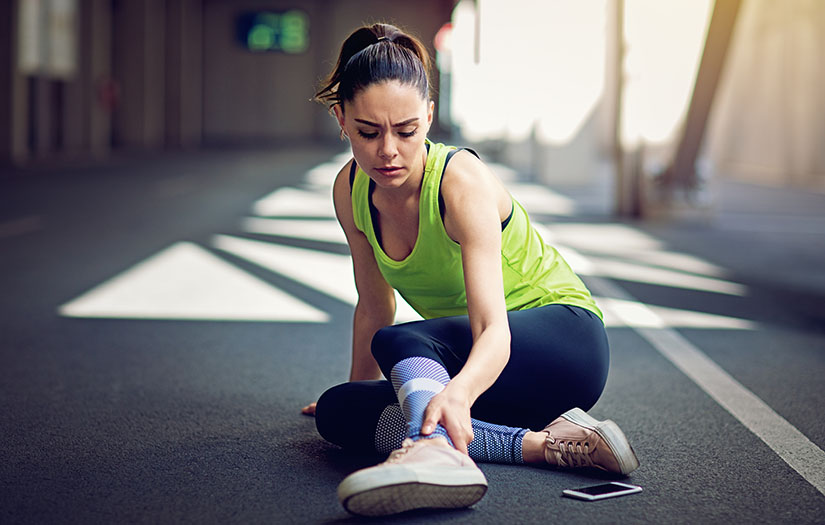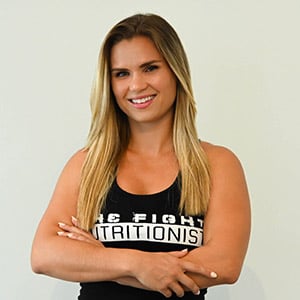Are you ever in the middle of a workout and then BOOM… it hits you? Your muscle is locked up, the pain sets in, and you need to take a bit of a breather to handle the discomfort. I think all of us at one point in time have experienced this phenomenon, which we often refer to as muscle cramping.Muscle cramping does not discriminate, it happens to everyone! Women, men, children, athletes, the elderly, pregnant women, and even animals! Ideally, we want to avoid muscle cramps as much as possible, but first, let’s dissect the root cause of this undesired pain.
Check out the NASM-CNC course for more helpful information on preventing cramps through nutrition.
Cramping Your Style
Interestingly, the etiology of cramping is still not fully understood. There are a few hypotheses to partially explain the occurrence of a cramp:
1. Cramping is caused by hyper-excitability of motor neurons.
2. Cramping results from spontaneous discharges of motor nerves.
3. Exercise-associated cramping results from altered neuromuscular control, which is common during fatigue and decreases carbohydrate and fluid availability.
With this hypothesis, it would be logical to assume that simple stretching exercises, fluid, and/or food consumption would be a curative modality for someone experiencing a cramp. However, one article points out that in healthy, athletic subjects there has been no direct correlation found between the depletion of fluids and alteration of electrolyte balance as the cause of cramps. Similarly, there is no definitive correlation between cramps and dialysis patients when they are depleted in electrolytes during treatment (1).
An additional consideration is that determining the cause of a cramp is very difficult. Often, the site at which a cramp occurs does not indicate the site that is experiencing an issue. Additionally, many factors outside of fluid/electrolyte depletion can play a role such as:
- age
- posture
- muscular imbalances/injury
- medication
- hormonal imbalances
- neurological disorders
- poor oxygen flow
- obesity
Common Muscle Cramp Issues
To date, the most common conditions that present with muscle cramps (outside of exercise) are:
• Nocturnal leg cramps (NLC): NLC affects about 37% of the population in America over the age of 60. The most affected muscle is the calf, and frequent stretching seems to help decrease the frequency of occurrence.
• Pregnancy-induced leg cramps: Muscle cramping in the lower limbs is very common during the last 3 months of pregnancy. The believed etiology is peripheral nerve compression and insufficient blood flow to the muscles. To date, there is no “treatment” for reducing cramping incidences. - see pregnancy exercises for each trimester for women's fitness content.
• Writer’s cramps: This is most found in individuals between the ages of 30-50 and seems to be an issue of the central neural network.
• Diabetes: Muscle cramping is more commonly seen in type 2 diabetes, especially when there is poor peripheral vascularization.
• Fibromyalgia: The hyper-excitation of the peripheral nervous system is believed to be the main cause of cramping in individuals that suffer from fibromyalgia.
Let’s Solve This Issue, Shall We?
While the exact etiology is unknown, are there solutions to help attenuate the duration of a cramp? Absolutely! Well… there are at least a few strategies one can try to see if they work!
The Best Solution for Muscle Cramps? Hydration!
Water is essential for transporting nutrients and lubricating the body’s joints. Electrolytes namely sodium, chloride, potassium, magnesium, and calcium are responsible for balancing fluids within the body and regulating muscle function.
One factor that can increase the risk of cramping is dehydration. Dehydration can occur when sweat loss begins to significantly exceed fluid and electrolyte replacement. As the fluid in the body decreases, so does the proper transport of vitamins and minerals. Electrolytes are equally important in preventing cramping since they each play a role in nerve and muscle function.
Sodium and potassium are needed to help muscles contract. Sodium exists in a higher concentration outside the cell, while potassium exists in a lower concentration inside the cell. When a nerve impulse stimulates a muscle to contract, the influx of sodium enters the cell and pushes potassium out.
Calcium and magnesium are also involved in the contraction of the muscle by allowing it to lengthen and shorten. Typically cramping occurs when a magnesium deficiency is present!
Chloride is important for maintaining the resting state of a muscle and participates in the excitability and fatigue of fibers.
The major electrolytes lost in sweat are sodium, chloride, and to a much lesser extent potassium, magnesium, and calcium. So, in minor states of dehydration (1-2% loss in body water), fluid replacement with the major electrolytes NaCl will be sufficient to rehydrate. However, if sweat losses exceed 3%, some consideration should be given to the other electrolytes to help prevent any muscle cramping.
What are some foods you can include in your diet to stay hydrated and prevent cramping if you’re getting bored of water and electrolyte packets?
Foods to Help With Muscle Cramps
1. Pickles
Not only are pickles full of WATER, but 1 medium pickle is loaded with 785mg of sodium! They are also a decent source of potassium, about 15mg for 1 medium pickle. A few of these during a long workout outside will most definitely help keep you hydrated and decrease the risk of cramping.
2. Salted Watermelon
Another fluid-filled fruit! Watermelon is 90% water and is also rich in magnesium and potassium (15.4 and 172mg for 1 cup). Sprinkle a little salt on top of this sweet fruit for a perfectly hydrating snack.
3. Trail Mix
Nuts and seeds are great sources of calcium and magnesium, important minerals for muscle contraction and preventing cramps! Trail mix is also often high in sodium, making it an excellent “hydrating” snack when paired with water.
4. Bananas
Bananas are an excellent source of potassium which is important for optimal nerve function during muscle contractions. Try them as dried plantains for an extra sodium boost to help maintain hydration and prevent cramps during long bouts of activity outside.
5. Salted Coconut
Coconuts are by far one of the richest sources of potassium. 1 medium coconut has 1413mg! That’s 40% of the daily value! Again, adding a sprinkle of salt to this sweet treat can help balance those electrolytes in your body to help prevent any muscle cramping that might occur from excessive activity.
What’s It All About?
Earlier in this article, we briefly covered some possible explanations for the etiology of muscle cramps. One is the hyper-excitability of motor neurons, in which a logical solution would be to stretch the muscle to get it to “relax”. Studies have shown mixed results on whether stretching decreases the likelihood of muscle cramps or attenuates pain associated with cramping.
However, if an easy solution to preventing cramping (especially during a bout of exercise) is stretching… why not try it?
For static stretches, it is recommended to hold a stretch for 25-45 seconds. This is the time it takes for muscle fibers to “relax”. Each stretch should be repeated 2-3 times. Another modality that is often recommended is dynamic stretching or stretching through a range of motion. Some examples include hip circles, spinal rotations, and walking lunges.
The mystery of what causes muscle cramping has still not been uncovered. However, many factors can increase the risk or likelihood of getting them such as old age, inactivity, obesity, prior injuries, poor nutrition, poor sleep, dehydration, hormonal imbalances, neurological issues, and the list continues!
While it’s easier to solve a problem when we know the cause, we do know that certain preventive measures can be taken to decrease the risk. So, stretch before performing any strenuous activity and stay hydrated as much as possible.

















